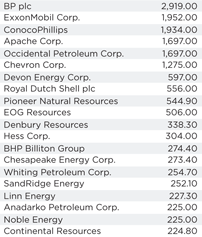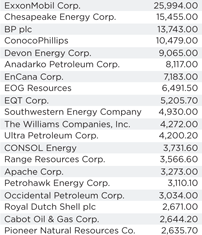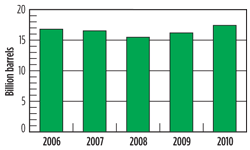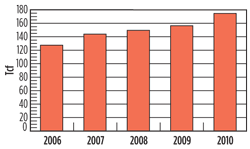|
End-of-year oil reserves grew by a double-digit percentage, and gas reserves rose comparably during 2010, posting the strongest, combined annual growth in the five-year period analyzed by Ernst & Young in its 2010 US E&P benchmark study. This compilation includes the 50 largest companies, based on 2010 end-of-year oil and gas reserve estimates. End-of-2010 oil reserves for the companies reviewed were up 11%, while gas reserves increased 12%. The latter number is the result of strong shale development.
| U.S. oil reserves, year-end 2010, million bbl |
 |
Oil reserves. Strong extensions and discoveries during 2010 fueled an increase to 17.8 billion bbl from the end-of-2009 figure of 16.1 billion bbl. Extensions and discoveries were 1.5 billion bbl in 2010, up 64% from 912.2 million bbl. EOG Resources recorded the largest oil extensions and discoveries (241.7 million bbl) in 2010, as the firm increased its focus on oil properties, some of which are included in the Eagle Ford and Barnett shales.
Oil production was essentially flat at 1.3 billion barrels in both 2009 and 2010. ExxonMobil saw a 10% increase in oil production in 2010, while several other of the integrateds experienced production declines. BP, ConocoPhilips and Royal Dutch Shell saw oil production declines of 11%, 9% and 17%, respectively.
Purchases of oil reserves were 1.1 billion bbl in 2010. The leading purchasers were ExxonMobil (374.0 million bbl), Apache (195.1 million bbl) and Denbury Resources (155.0 million bbl).
Sales of oil reserves were 734.5 billion bbl in 2010 compared to 168.7 million bbl in 2009. The most significant sales (excluding XTO Energy) were reported by BP (117.0 million bbl), Denbury Resources (50.6 million bbl) and Devon Energy (45.0 million bbl).
The break-out of end-of-2010 oil reserve holdings was split 51% among integrateds, 31% by large independents and 18% by smaller independents.
| U.S. gas reserves, year-end 2010, Bcf |
 |
Gas reserves. Gas reserves rose from 156.2 Tcf in 2009 to 174.3 Tcf in 2010. However, extensions and discoveries decreased 1% from 27.8 Tcf in 2009 to 27.4 Tcf in 2010. Among producers, Chesapeake Energy had the most significant extensions and discoveries at 4.7 Tcf, as a result of the company’s active drilling program during 2010.
Production grew 1% in 2010 to 11.9 Bcf compared to 11.8 Bcf in 2009. The largest production increase in 2010 was reported by ExxonMobil (491.0 Bcf ) and was largely due to additional unconventional gas volumes. Southwestern Energy followed with a production increase of 103.9 Bcf, primarily attributable to its Fayetteville shale play.
The leading purchasers of gas reserves in 2010 were ExxonMobil (12.8 Tcf) and Apache (951.7 Bcf) for their previously discussed acquisitions. CONSOL Energy (946.8 Bcf) followed, due to its acquisition of Appalachian basin assets from Dominion Resources, Inc.
Sales of gas reserves were 17.3 Tcf in 2010. The most significant sales (excluding XTO Energy) were reported by Chesapeake Energy (1.4 Tcf).
The break-out of gas reserves was evenly split between the peer groups-—32% for integrateds, 34% for large independents and 34% for smaller independents. 
Editor’s note: The U.S. Energy Information Administration (EIA) has delayed the release of its estimates for U.S. oil and natural gas reserves for 2010 until April 2012. This year, due to the EIA delay, we have used Ernst & Young’s 2010 US E&P benchmark study.
|






